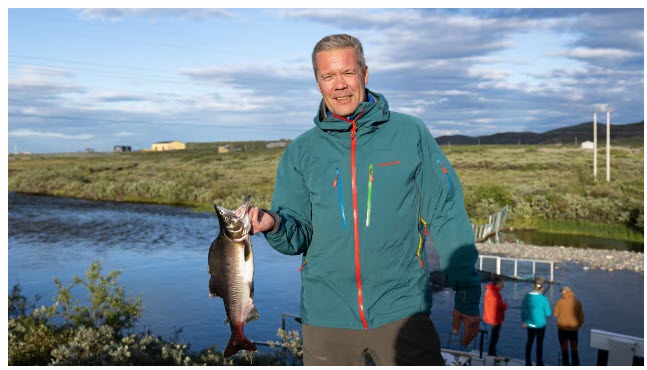More than half a million humpback salmon threaten to enter the Tenojoki River
A way to stop the invasive species has been found, but Finland is hesitant to apply it.
Finland is interested in using the control technique from Norway, though.
JARMO SIIVIKKO
13.9. 5:15
The Norwegians have the same problem as the Finns in the Teno River. The Storelva River in northern Norway is overrun by aggressive salmon that threaten native salmon stocks.

Humpback salmon (Pink Salmon)
Now the Norwegians have begun to combat the unwanted invasive species with “facial recognition technology”, which Huawei is testing in collaboration with the Berlevåg Hunting and Fishing Association.
The technology, installed in Storelva, uses a camera, a computer algorithm and a mechanical device to distinguish humpback salmon from Atlantic salmon.
– Each salmon, or any fish, is led into a tunnel where it is recorded on video. The image is sent to a computer, which identifies the fish in eight milliseconds. Based on that, we open the door for release or lock the fish in a catch basin,” says Vegard Kjenner, Norwegian CTO at Huawei.
After classification, native Atlantic salmon and Arctic salmon are released through the gate to continue their journey in the river. Humpback salmon are killed and eaten.
The entrepreneur in northern Norway has promised to buy all the humpback salmon he can get his hands on. Despite its bad reputation, the humpback salmon is a very good food fish as long as it is in the sea.

Vegard Kjenner, Norwegian CTO at Huawei, believes technology can solve the problem of humpback salmon in the north. Photo: Vesa Toppari / Yle
More efficient than humans and it always works
Storeleva uses self-learning artificial intelligence that improves accuracy and efficiency image by image. According to Kjenner, the imaging system has been fed with thousands and thousands of images of humpback and Atlantic salmon.
The algorithm was developed by Silo AI, a Finnish company. The recognition rate is currently close to 100 per cent.
Using this technology is much faster and more accurate than removing salmon with a handheld device. As an example, Kjenner cites Kongselva, where 1,700 humpback salmon were caught by hand last summer. It took 1,700 hours.
Traditional conservation methods for Atlantic salmon are laborious. Volunteers dive to the river bottom and identify the humpback salmon by hand or by the naked eye based on spots on the tail.
– The best part is that the technique works 24/7 and requires no breaks,” says Kjenner.
Now the human role is mainly to monitor the system and occasionally take the humpbacks out of the tank. The system alerts when there are a certain number of salmon in the tank. In Norway, these tasks are carried out on a voluntary basis by local fishing associations.
The operations are largely secure and automated. The electricity used by the system is generated by solar panels, among others.
A wave of humpback salmon comes to the Teno River
Humpback salmon have multiplied and spread so rapidly that they threaten the existence of Atlantic salmon and other wild fish.
Scientists are concerned about the threat to Atlantic salmon and the threat is growing. An invasion of up to 500,000-700,000 fish is predicted for the Tenojoki River next summer. The Finnish Natural Resources Institute (Luke) estimates that it is only a matter of time before they also appear in the Baltic Sea.
Luke’s researcher Panu Orell expects that the detection system could also be tested somehow at the Teno River next year. According to Orell, this could make counting the number of fish per year easier and faster.
– And, of course, it is an efficient, time-saving methods. At the same time, it reduces the handling of the fish and thus the stress they experience. On the other hand, using it requires quite a lot of equipment in the main mouth of the Teno River and is an expensive solution,” Orell said.

In northern Norway, sport fishermen caught a total of 13,000 humpback salmon from several rivers during the summer of 2021. The photo shows the pilot dam for the Storaelva salmon fishery. Photo: Vesa Toppari / Yle
According to Orell, technological catching of humpback salmon on the Teno River is challenging and laborious, to say the least. The river is huge.
– When you think of a large river the size of the Teno, it means that somewhere downstream in Norway there must be a strong catch in the whole river. If the fish can get there upstream to the spawning grounds, we should try to catch them even more locally,” Orell said.
So far, Finland has tested a fishing model based on old traditional fishing methods, where humpback salmon are caught in the Teno River using driftnets and dams. Moreover, other effective fishing methods are needed.
– For this fishery, we need local fishermen who are skilled in traditional fishing and know the river well, and we have already attracted them,” Orell said.
Source: Yle
